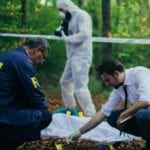 Food
Food  Food
Food  History
History 10 Odd Things Colonial Americans Kept at Home
 Weird Stuff
Weird Stuff 10 Superstitious Beliefs That Once Consumed Entire Cultures
 History
History 10 Bizarre Friendly Fire Incidents in Military History
 Technology
Technology 10 Modern Technologies That Accidentally Imitate Ancient Magic
 Mysteries
Mysteries 10 Mysteries of the Human Genome
 Weird Stuff
Weird Stuff 10 Things So Rare They’ve Only Been Found Once
 History
History 10 Legends Whose Last Moments Undid Their Glory
 Health
Health 10 Futuristic Ideas to Treat Common Medical Problems
 Weird Stuff
Weird Stuff Ten Surreal Attempts to Reverse Baldness
 Food
Food 10 Everyday Foods You Didn’t Know Were Invented by the U.S. Military
 History
History 10 Odd Things Colonial Americans Kept at Home
 Weird Stuff
Weird Stuff 10 Superstitious Beliefs That Once Consumed Entire Cultures
Who's Behind Listverse?

Jamie Frater
Head Editor
Jamie founded Listverse due to an insatiable desire to share fascinating, obscure, and bizarre facts. He has been a guest speaker on numerous national radio and television stations and is a five time published author.
More About Us History
History 10 Bizarre Friendly Fire Incidents in Military History
 Technology
Technology 10 Modern Technologies That Accidentally Imitate Ancient Magic
 Mysteries
Mysteries 10 Mysteries of the Human Genome
 Weird Stuff
Weird Stuff 10 Things So Rare They’ve Only Been Found Once
 History
History 10 Legends Whose Last Moments Undid Their Glory
 Health
Health 10 Futuristic Ideas to Treat Common Medical Problems
 Weird Stuff
Weird Stuff Ten Surreal Attempts to Reverse Baldness
10 Amazing Stories Of Amnesiacs Reuniting With Their Families
Amnesia sounds like a plot device in a soap opera. While it rarely happens, people have been known to have severe amnesia and go decades without knowing who they are. This problem is even worse when the amnesiac is found far from home. But sometimes, under miraculous circumstances, they are reconnected with their families.
10 Cheryl Ann Tomiczek

In September 1980, a police officer was patrolling Hugh Taylor Birch State Park in Florida when he saw something odd among the trees. Deciding to investigate, he found a woman caked in dirt in a shallow grave. Amazingly, she was still alive.
She was taken to the hospital where they found that the woman was near starvation, had sores all over her body, and had no memory of anything. She couldn’t even remember the taste of mustard.
There were few clues as to how the woman had ended up in the woods. Although she said that she couldn’t remember much, she was sure that she hadn’t been attacked. Her clothes had been folded neatly next to her, and four Styrofoam cups were strewn about the ground. The woman had only 12 cents in her pocket.
Her body was also fairly typical. Besides some moles on her face, she didn’t have any scars, tattoos, marks, or even a vaccination scar, making the investigation into her identity even more difficult.
In February 1981, the woman, who was called “Jane Doe,” appeared on Good Morning America, hoping that someone would recognize her. The police were flooded with calls and letters from families hoping that Jane Doe was their missing loved one.
Amazingly, one of the people watching was Irene Tomiczek of Roselle, Illinois. She knew that Jane Doe was her 34-year-old daughter, Cheryl Ann Tomiczek. Cheryl Ann had moved to Florida seven years earlier.
Two years after Cheryl Ann had settled in Florida, Irene lost contact with her daughter following a rather disturbing phone call. Cheryl Ann sounded upset, and Irene could hear someone in the background. Irene asked Cheryl Ann if she wanted to come home. But Cheryl Ann snapped and said she never wanted to talk to her mother again.
In March 1981, Irene flew to Florida to see Cheryl Ann, who was still using the name Jane because she liked the sound of it. Irene confirmed that Jane was her daughter. In April, Cheryl Ann returned to her family’s home in Roselle. She didn’t remember her parents but said they were “nice people.”
9 Jeffrey Alan Ingram
On September 10, 2006, a man in his late thirties or early forties walked into a hospital in Denver claiming that he had no memory of who he was. He said that he had awoken on the street and then spent six hours asking for help before he came to the hospital.
He was diagnosed with a dissociative fugue, a rare type of amnesia that is often brought on by stress. For six weeks, the man had no idea who he was. On October 22, 2006, the man was featured on some national news programs. He asked anyone who recognized him to come forward.
Luckily, someone did recognize him, and they notified his fiancee. The fiancee contacted the police and said that the man was 40-year-old Jeffrey Alan Ingram from Olympia, Washington. He lived about a 20-hour drive from where he initially woke up.
Ingram went missing on September 6 when he was traveling to Canada to see a friend who was dying of cancer. After he was identified, Ingram flew to Seattle where he met up with his fiancee and his mother. But he still couldn’t remember much of his past.
Amazingly, this isn’t the only time that Ingram has suffered a dissociative fugue. In 1995, he went to the grocery store and disappeared. Nine months later, he was found in a Seattle hospital. But he didn’t recover all of his memory after that incident.
8 Ruth Ellish

On December 10, 1989, a woman awoke with a terrible headache in a Nashville motel room with no memory of who she was or how she had gotten there. Her arms and legs were bruised, and she had a black eye. In a pocket of her coat, she found a note with the name Kitty Jordan on it and assumed that was her name.
She went to a women’s shelter where she got a job as a cook. In September 1989, over 10 months after she had arrived in Nashville, the police asked for the public’s assistance in identifying her.
When the story went national, some relatives were watching and identified the woman as 50-year-old Ruth Ellish, a divorced mother of two from Dayton, Ohio. The police investigated the claims and found that Ruth Ellish had gone missing on December 8, 1989, two days before Kitty woke up in the motel.
Ellish’s family traveled to Nashville. She planned to travel back with them for a short visit but intended to return to Nashville because that is where she felt at home. She also kept the name Kitty because she liked it more than Ruth.
As for her family, she didn’t recognize her mom or her sister but had no doubt that they were her relatives.
7 Celestine Gandy Thompson

In 1957, Celestine Gandy Thompson, 14, left her home state of Mississippi and eventually settled in Buffalo, New York. In 1992, Thompson survived a fire but remained in a coma for two years. When she woke up, she couldn’t remember much about her early life or her biological family.
Over the next couple of decades, Thompson worked on regaining her memory. But she could only remember one name from her past: Clarence Woolard. He was her nephew and was able to get in contact with the rest of her family. They all thought that she might have died because they hadn’t heard from her in years.
Once they reconnected, some of the family flew to Buffalo to see her. Then in 2014, a big family reunion was planned. For the first time in almost 60 years, Thompson reconnected with much of her lost family. She also found out that she had 23 nieces and nephews, 64 grandnieces and grandnephews, 66 great-grandnieces and great-grandnephews, and 34 great-great-grandnieces and great-great-grandnephews.
6 Ashley Manetta
In February 2015, a middle-aged woman was found wandering around a beach community in Carlsbad, California. When the police picked her up, she had no idea who she was. They took her to the hospital, and the doctors diagnosed her with ovarian cancer. They believed that the antibodies from the tumors had given her amnesia.
Over the next five months, the police and the FBI tried to identify the woman, who was calling herself “Sam.” But their search didn’t produce any results. So in late June 2015, the nurses at the hospital where Sam was staying got the local news involved, and the story went viral.
Two days later, the nephew of the woman identified her as 53-year-old Ashley Manetta. She had lost contact with her family after moving to California in 2013. After the discovery, Manetta said that she would fly out to Maryland where her sister lived so that she could be reunited with her family.
5 Mary Joyce Howard

In February 1998, a woman in her late forties was found critically injured off an interstate near Erick, Oklahoma. She was taken to the hospital where doctors performed major brain surgery, leaving her without the ability to speak for some time.
She didn’t have any ID on her, and the only things in her bag were shorts and a halter top. The only thing to identify her was a rose tattoo above her left breast. Eventually, the woman, who was called “Jane Doe,” regained some ability to speak, but she didn’t know her name.
Then, on January 10, 2000, she was hospitalized in Oklahoma City with pneumonia. When a nurse technician asked Jane Doe her name, she said, “Joyce.” Then she corrected herself and said, “Mary Joyce.”
The nurse continued to ask questions to prod her patient’s returning memory. Mary gave her full name, her birthday, her hometown, and the names of some of her family members. The breakthrough came when Mary remembered the first few digits of her social security number.
Using that information, the police found fingerprints from an arrest in 1980 for a Mary Joyce Howard from High Point, North Carolina. From there, they were able to contact her father. In February 2000, a doctor and two paramedics, all volunteers, traveled 18 hours to bring Mary home to be reunited with her family.
4 David Yerke

On the day after Christmas 1945, 28-year-old David Yerke, a husband and father of one, set off on a solo trip from Tarpon Springs, Florida, to do some sponge fishing. A week later, the dinghy from his boat was found in Bayport, Florida, which wasn’t far from where he had set off. But there was no sign of Yerke, and his family assumed that he had drowned.
Yerke was actually all the way across the Gulf of Mexico in New Orleans, Louisiana, supposedly suffering from amnesia. He was using the name “Reuben David Dry.” In February 1946, he married again.
Eventually, he got a job as an orderly at a nursing home. Five years later, in the fall of 1951, Yerke apparently had a mild paralytic stroke, which helped to jog his memory. He remembered that his name was David Yerke and that he had family in Detroit, Michigan.
With these rediscovered memories, David looked up his brother, Norman, in Detroit and called him. Norman was shocked and wired David the money to fly home. Norman then called David’s wife and told her that David had been found. She and David’s daughter, who was now six, flew to Detroit, and they all spent Thanksgiving together for the first time in five years.
Interestingly enough, Yerke’s wife in New Orleans had no idea where he had gone when he went to Detroit. She filed her own missing person’s report. Needless to say, she was shocked to find out that he had another family.
3 Jack Duffey

In May 1941, a young man about 13 years old found himself riding a blue bike near Rochelle, Illinois. He couldn’t remember why he was there or who he was. After befriending a family in Rochelle, he lived and worked with them for three years under the name of “Gerald Smith.” Then he got a job as a truck driver.
Twelve years after losing his memory, Smith was driving across the country with fellow trucker Albert H. Gargione when Smith explained that he couldn’t remember anything before that day when he was riding his bike. Gargione became intrigued and decided to look into it.
On December 30, 1943, he went to the missing persons division of the police department for help. He also contacted the Chicago Daily News. The newspaper did a story on Gerald Smith, which included three pieces of information that Smith remembered—the name “Betty Shumaker,” the address “426 Erie Avenue,” and finally, the date “June 26, 1927.”
After the story ran, a woman named Betty Peterson wrote to the newspaper and said that her maiden name was Betty Shumaker. She had once lived at 4622 West Erie Avenue. Believing that she might be able to help solve the mystery, the newspaper invited her to meet the man who called himself Gerald Smith.
When Peterson laid eyes on Smith, she said, “You’re Jack Duffey, I’d know you anywhere.” They had met 13 years earlier at a two-week summer camp in Wisconsin. Peterson also remembered that Jack had been from Rockford, Illinois.
The police looked into their records and found that 13-year-old Jack Duffey was reported missing on May 19, 1941. He was last seen riding a blue bike on his way to his aunt’s farm.
On January 13, 1953, almost 13 years after he went missing, Jack was reunited with his mother and sister. They instantly recognized him. Other people at the meeting also noted the strong resemblance between the three family members. As for the third piece of information that Duffey had remembered, it was the date of his birth.
2 Edgar Latulip
On September 2, 1986, Edgar Latulip, a 21-year-old developmentally delayed man with the mental capacity of a 12-year-old, walked out of his group home in Kitchener, Ontario, without his medication. Police thought that he had taken a bus heading toward Niagara Falls, Ontario, about 90 minutes away.
Beyond that, they were unsure what had happened to him. The police thought that he might have traveled to Niagara Falls to commit suicide. Edgar’s mother was worried that someone had taken advantage of his developmental problems. She feared that someone was abusing Edgar or had murdered him.
However, Latulip was alive. He had traveled to Niagara Falls, but along the way, he had somehow sustained a head injury. After that, he couldn’t remember his name or anything about his identity. For the next 30 years, Latulip lived under an assumed name in St. Catharines, a neighboring city of Niagara Falls.
Then, in January 2016, Latulip had a meeting with a social worker and said that he thought his name was Edgar Latulip. The social worker searched his name and found a story about him in a Niagara Falls newspaper from 2014.
The police interviewed Latulip and tested his DNA, which proved that his true identity was Edgar Latulip. A short time later, his mother was contacted with the news. She was thrilled and planned on meeting with him as soon as possible.
1 Roland Franklin Gilman

On April 14, 1955, Roland Franklin Gilman, 34, walked out of his house in Bridgeton, New Jersey, to go to work. Even though it was his daughter’s third birthday, Gilman didn’t return home to his wife and two daughters.
He was close to a nervous breakdown when he disappeared. After searching for Roland for seven years, his family had him declared dead. They didn’t find out what happened to him until 36 years later on the same date that he had disappeared.
According to Gilman, he had gone to Philadelphia and wandered around aimlessly that day. Then he realized that he couldn’t remember who he was. He started to use the name “Bob Greene” and worked as a carpenter. But he couldn’t remember his life before 1955.
In 1985, he visited Shiloh, New Jersey, which is close to Bridgeton, and some of his memories started to come back. But he didn’t look for his true identity until a few years later when he applied for social security.
In 1989, he finally discovered his true identity. Three years later, he reconnected with his family. Gilman wishes that he could remember what happened because he feels that he’ll never get those missing years back.
Robert Grimminck is a Canadian freelance writer. You can friend him on Facebook, follow him on Twitter or on Pinterest, or visit his website.








